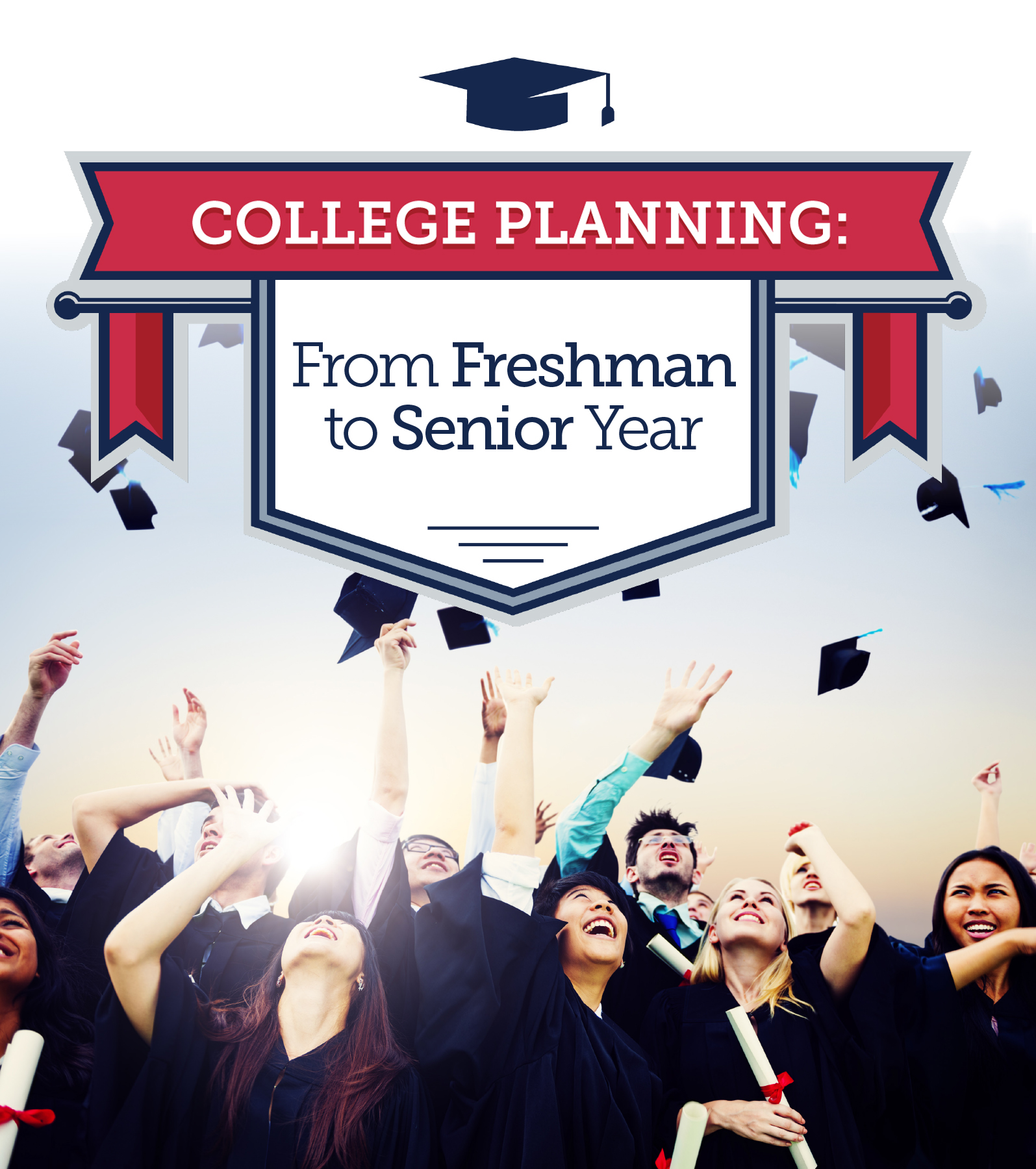by Diane Masiello
College-bound students who start planning for college during their freshman year will find the process much less stressful and time-consuming than those who wait to start during their senior year. However, every person is unique. Some may not want to go straight from high school to college, opting instead to join the military, apprentice in a trade or travel the world. Others may know they want to get specialized and competitive degrees from the time they are in grade school. All students should be encouraged to follow their own path, especially if finances are an issue. College can be almost prohibitively expensive for some, and taking on too much college debt can be disastrous.
Students planning to attend college straight from high school can take a number of steps to navigate the process successfully. However, suppose a student is committed to a competitive career path. In that case, she should start investigating ways to get a leg up on the competition by talking to people in the field who might offer their expertise or advice on maximizing her high school years to gain admission into the best programs available. Everything a teen chooses to do from 9th to the first semester of 12th grade is potential material for their future college applications.
Freshman Year: Explore
- Focus on core subjects like English, math, science, history and foreign language, making sure he is properly placed. Colleges would much rather see good grades in a lower-level class than horrible grades in a high-level class. If a student overreaches and gets a bad grade, colleges will just want to see the grade improve in future semesters.
- Join teams and clubs, participate in extracurricular activities, take enrichment classes, and start volunteering to explore outside interests and hobbies. College admissions departments want to see a crafted narrative—the story of who the student is, what he enjoys, where he excels, what he has earned about himself, and what unique qualities he can bring to their school. These experiences will be an ideal starting point for that narrative.
- Get a handle on any issues that may impede academic success. Take note of sleeping, eating and technology-use habits and get them in order. If a student struggles with anxiety or depression, this is a good time to seek help.
- Select sophomore year courses based on the year’s academic experiences, which should have provided a general sense of academic aptitude and work ethic.
- Consider taking summer classes that will get certain high school requirements out of the way. Some school systems offer these virtually, and doing so will allow students to focus on courses in areas that interest them in junior and senior years.
- In the summer, take classes, workshops or attend camps that allow the student to explore her interests. Finding an internship may be difficult, but if she already knows she wishes to pursue a degree in a competitive field, she can reach out to professionals to see if she can shadow for a day or week. If nothing else, this will make her recognizable when she calls again after her sophomore and junior years.
- Volunteering is essential, and summer is an ideal time to do so. Students often find their passions and career paths through volunteer opportunities. They also make community connections which can help them when job hunting in the future. At a minimum, volunteer experiences make excellent topics for college entrance essays.
- If money is an issue, get a summer job if legally able to do so. This, too, can be part of the college narrative.
Sophomore Year: Focus
- In academics, apply insights gleaned in freshman year. A B- in freshman math which rises to B+ or A- in sophomore year, shows growth and maturity. However, grades should not fall, so keep refining sleeping, eating, socializing and study habits as work gets harder.
- Focus on extracurricular activities which he most enjoys and at which he excels.
- Start putting together a CV to list any academic awards, extracurricular activities or achievements, club participationand leadership positions.
- Summer activity planning can begin as early as February when many programs open registration for competitive summer camps. Make sure to research and register as soon as possible. If camps are not in the budget, a student can start looking into possible summer jobs that align with his areas of interest.
- Look at a few (no more than three) colleges to get a sense of their average student’s GPA and standardized test score. If the student’s current academic record is not on track, consider exploring options either for tutoring and enrichment or find colleges for which she is on track.
- Junior year course selection is paramount. Students will want to take a successfully challenging curriculum. College admissions officers look at what a student does based on what the high school offers, and students will be judged based on the degree to which they successfully take advantage of those opportunities. This is tightrope time—how much can the student take on and still do well? Hopefully, through trial and error over the past two years, he has come to understand his strengths and weaknesses and should use that knowledge in selecting courses.
- Consider what leadership positions in clubs, extracurricular activities and volunteer organizations are open to juniors and run for them.
- Over the summer, attend camps related to possible career interests, take enrichment classes and capitalize on volunteer opportunities. Call back the field professional to see if shadowing is possible or stay on her radar.
- Consider taking a PSAT prep course if the student might be running for a National Merit Scholarship. Khan Academy offers a self-directed one for free.
- If the student has identified any universities of interest located where the family is vacationing or near the summer camp he is attending, schedule a campus tour.
- If struggling in any subjects, get extra tutoring to be ready for upcoming challenges.
Junior Year: Crunch Time
- Academically, students need to be at the top of their game. If they are taking dual enrollment classes or Advanced Placement classes, falling behind can be disastrous.
- Take the PSAT in the fall and perhaps one SAT or ACT to get a baseline. Sign up for prep classes based on those scores, which come back about four to six weeks after testing. Khan Academy offers self-directed prep courses for free. Though many colleges are becoming “test optional,” an excellent standardized test score will still be a requirement for scholarships and can tip the admissions team to accept a student if their GPA is not stellar.
- Start crafting a personal narrative. Keep adding to the CV started at the beginning of sophomore year, but create another file turning it into a story of where the student started and where she is now, what interests she would like to pursue in the future, what she is drawn to, her passions and what she is doing to follow them.
- Research colleges in earnest. If pursuing a definite career track, find the best colleges offering degrees in that field whose entrance requirements are within the student’s GPA and standardized test score range. If still up in the air about a career choice, find colleges offering a wide array of programs and majors.
- Make a list of at least five colleges. Conventional wisdom says the ideal college or university is where the student will be in the top 25% of the class. Thus, the list may contain two “stretch schools” he may or may not get into; must contain two he’d like to attend and whose requirements he meets; and at least one “safety school,” which he already has the GPA and test score get into. It is probably not wise to make a list of more than fifteen.
- If applying to many schools, make a spreadsheet containing the school’s name, the SAT/ACT score range for admission and scholarships the required GPA range for admissions and for scholarships and the admissions deadlines for things like early decision, honors programs and scholarships.
- Start researching specialized summer camps for rising high school juniors in January. The best ones fill up fast, and many will require registration to be completed by February or March. If the student needs to work, she can start looking for paid summer opportunities that align with her interests.
- Sign up for at least one “real” SAT or ACT, if not both. Spend lots of time on test practice unless the initial “practice” scores are high enough already for admissions and scholarship purposes.
- Run for the top leadership opportunities in clubs, teams and volunteer organizations.
- Ensure the student is on track to meet all high school graduation requirements and sign up for summer classes if necessary.
- Course selection for senior year is as important as it was junior year. Colleges will be basing admission on a transcript that includes the first semester of senior year classes. Colleges want to continue to see the balance of challenge and personal strengths exhibited in the junior year course schedule, if not more. During senior year, most college-bound students will take at least one or two AP courses if they haven’t done so already. Most advisors recommend students take only between three and five. Some students may choose to take dual enrollment courses in colleges over the summer or during senior year or take a local community college class.
- Ask at least two teachers if they would be willing to write excellent letters of recommendation. This gives them the summer to do so. The teachers should know the student well enough to write in detail about his work ethic, personality and achievements. Ideally, he should comment on the student’s suitability for college and the field he may have identified.
- Schedule college tours.
- If the student did not attain the SAT or ACT score necessary to gain admission to and scholarships from the colleges on his list, take a prep course. Most colleges accept what is called a “superscore”—if the student has taken the exam twice or three times, they can take the top score from each section to make the highest score possible.
- College admissions portals for the Common App—the way most students apply to most colleges—open around August 1st. Students should at least log in and start exploring the app, filling in the basic information and checking to see if the college takes just the common app or has extra requirements.
- Start drafting college essays based on information from the common app. Some colleges don’t require essays. Others require multiple writing samples. If students have been working on their CV and narrative since freshman year, they will not struggle to come up with something to write.
- Extend the college spreadsheet based on the information gleaned from the Common App, especially specific admissions deadlines. Some take rolling admissions and advise applying as early as possible because scholarship money gets awarded on a first-come, first-served basis. Others offer “early decision.” If a student applies for early-decision, she guarantees she will go to that college if she is admitted, regardless of scholarship offers. Still, others offer a combination of rolling admission and early decision, where students are given preference even if they don’t guarantee their commitment to attend the school. Every college is different. Summer is time for her to figure all of these things out and add them to the spreadsheet, so she stays on track.
Senior Year: Push to the Goal
- If necessary, take the ACT or SAT to maximize the super score. Include time for test prep.
- Keep focusing on academics. Grades still matter for college admission.
- Remind the two teachers from last year that they agreed to write an excellent letter of recommendation, and make sure to get the letters in time for application deadlines.
- Parents must fill out the Free Application for Federal Student Aid (FAFSA). Even if parents do not think they will qualify for any student aid, most colleges will not offer merit-based scholarship opportunities if the student’s family does not submit a FAFSA. Every college’s deadline differs, and since they require the latest tax information (which will be from the spring of the junior year, though parents may be asked to provide the next year’s tax return to maintain financial assistance eligibility), parents should fill out the form as soon as it becomes available—usually around August of the summer before senior year.
- Write all college essays and other narrative requirements. Make sure the essays are thoroughly proofread—“loose” will not trigger the spell-check even though the student meant to write “lose.”
- Make sure to contact the college board and instruct them to send SAT/ACT super scores to colleges. This can often be done through the Common App. If the school is test-optional and the scores are sub-par, consider not sending them. However, some schools will accept test scores for scholarship purposes even after the admissions deadline, up until the end of summer after senior year.
- Fill out all college applications as thoroughly as possible, as soon as possible. Do not ignore sections asking if family members have attended the college. Children of alumni are considered “legacies” and are sometimes given an edge in admission, all other things being equal.
- Closely follow directions about when and how to submit the applications. Most college deadlines are between October and December.
- After submitting the application, students vying for admission to specialized programs may be called for an interview or audition. These will be scheduled for late fall/early spring.
- Admissions decisions start coming in between January and April. Competitive schools may only accept 3% of applicants. Not receiving an acceptance despite meeting or exceeding all qualifications is not a judgment of character or the student as a person. Sometimes one student gets admitted over another because he plays a sport the college is trying to promote or has a talent the school orchestra needs. This is why applying to multiple schools is a must. There are no guarantees.
- If a student is waitlisted to the school she wishes to attend above all others, she may write to the admissions department to let them know that she promises to accept admission to the school if she is taken off the waitlist. It may not work but it doesn’t hurt to try.
- Students who are accepted to multiple places may wish to visit their top choice campuses before committing. Those students should again consider the caveat that the best school to attend will be where they are in the top 25% of applicants.
- Deadlines for enrollment are usually May 1st of senior year. Students who have been waitlisted for their top-choice school may need to accept an offer from another college and be prepared to lose the registration fee if they are taken off the waitlist. This can, unfortunately, happen any time after May1st and before the official start of school.
- If the student has not gotten into their ideal college, he can always look into transferring after his first or second semester of freshman year. It’s not a great feeling, but it’s certainly done all the time. Other students may choose to take a gap year. Still, others may come to love the college which accepted them so much they won’t want to leave.
- Remember, college admission is not the end; it’s the beginning of adult life. There will be successes and failures, acceptances and rejections. They are all just moments; what matters is how we deal with them.
Regardless of the path students take or the decisions they make, the experience of tailoring their high school years to meet the requirements of college admission will help them better understand themselves, their goals, their work ethic, their passions and their aspirations. If done properly, it will serve them well throughout their adult lives.








Leave A Comment